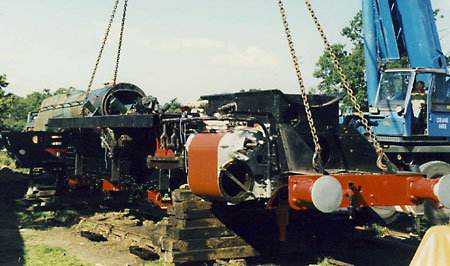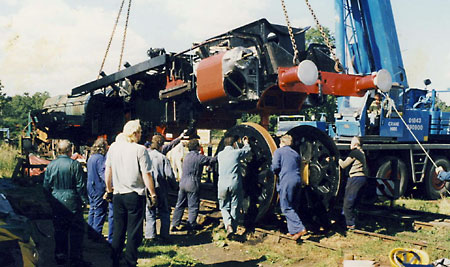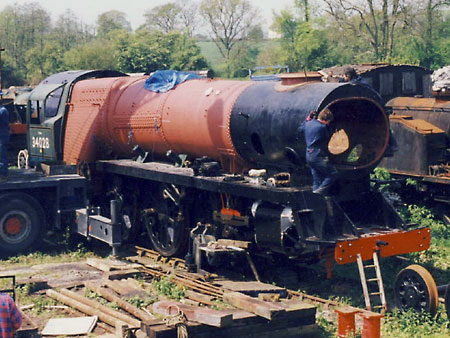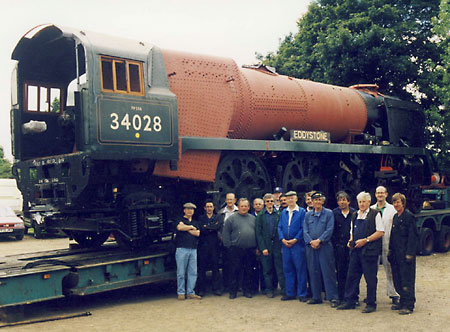34028 Eddystone – Restoration
The Story of the Southern Pacific Rescue Group
Like many other restoration projects, the Southern Pacific Rescue Group was born out of an individual's desire to restore a steam locomotive. A meeting of the Barry Steam Locomotive Action Group in November 1981, convened by Mike Cockayne for people interested in rescuing the remaining locomotives at Barry, brought together Richard Moffatt and Colin Hebbes. This was followed up by a visit to Barry and a meeting with Dai Woodham.
A report on Eddystone listed defects such as cracked frames, wasted firebox, shot bearings, pitted boiler barrel, bent axles, asbestos contamination, etc., and of course it had no tender. However, in true pioneering style a reservation was made on the locomotive and the Southern Pacific Rescue Group was born. A second visit to Barry was made by the embryo group, now numbering four, to carry out some preliminary tasks to prevent further deterioration such as oiling the axle boxes, cylinders and the motion.
The next problem was fund raising, i.e. persuading unsuspecting individuals to part with money for a pile of rusting metal. Adverts in the Railway press and local papers swelled the membership ranks but funds were still considerably less than the £6500 that was the asking price for a Light Pacific.
The fund raising problem was resolved by the adoption of the method of part-ownership capitalization, similar to that used to finance Port Line. Their bank was approached for a loan and this was agreed provided there were sufficient standing orders to cover the loan repayment.
A new problem arose in May 1984 when the reservation was challenged by another railway. The price of scrap metal had continued to fall and £6000 was now the price for a Bulleid Light Pacific. A hasty trip to the bank was met with the response by the manager that with the reduction in the asking price, only one more standing order was needed. The bank manager then pushed across the desk a standing order form which he had completed on his own behalf.
A cheque was sent to Woodham Bros. to complete the first stage of the project.
Restoration at Sellindge
Eddystone arrived at Sellindge from Barry on 26th April 1986, minus a lot of parts and no tender.
Work then progressed on several fronts.
A number of new or used parts were procured as funds became available. These included steam injectors, cylinder drain cocks, lubricators and a number of motion parts including the weighshaft, outside radius rods and return cranks. Other acquisitions included water gauges, speedometer, the vacuum brake ejector and most of the sanding gear. A surprise acquisition was the arrival by post of one of the drop links, sent by someone with a conscience who had removed the part from the locomotive at Barry. It was hoped that other missing parts might arrive in a similar manner!
The locomotive was completely stripped down, allowing the frames to be grit blasted and painted. No major repairs were necessary apart from the need to replace the dragbox. This item was fabricated at Bitton and eventually fitted to the frames.
The locomotive was fully inspected by BR and a report received detailing work to be undertaken before a main line ticket would be granted. It appeared that the locomotive was in a much better condition than many other former inhabitants of Barry, in particular the boiler, which only required the replacement of a few stays and some remedial firebox work.
The lack of a tender was not overlooked and the group purchased a snowplough from RailTrack. (Presumably RailTrack do not need snowploughs as they were built for the wrong type of snow). Surplus tenders were converted to snowploughs by BR and, although the frames are not the correct type for a Bulleid tender, it provided a source of axle-boxes and hornguides.
The wheelsets were sent to Swindon for machining and tyre turning and the axle-boxes were re-metalled and machined in preparation for the re-wheeling of the frames.
Work was also carried out on the lubrication system prior to re-wheeling involving the installation of seemingly endless lengths of copper pipework and associated lubricators.
Re-wheeling the Frames
The 13th September 1997 saw Eddystone pass its first restoration milestone with the re-wheeling of the frames. A large crane had been hired for the day and a large workforce turned out to assist and watch.
 |
Eddystone's frames being lifted |
 |
The driving wheels being rolled into place |
Boiler Reinstated
Eddystone reached another milestone in May 1998 when its boiler was lifted back onto the frames.
 |
Eddystone with boiler in place |
Winter 1998/9
Work continued on the difficult task of reinstating the driving wheel springs. This was particularly difficult as there was no pit in which to work. The springs weighed about 300lb and needed to be lifted up to the frames in a confined space.
The pipe runs for the steam brakes and drain cocks were all reinstated as were the outside pistons. Work also continued on the cylinder cladding and restudding in preparation for the fitting of the cylinder covers.
The front bogie was re-wheeled and reinstated under the locomotive utilising the crane that was hired to remove Sidmouth's boiler.
Summer 1999
During the spring of 1999, Eddystone became a 4-6-2 locomotive once more. Most of the work carried out has been to prepare the locomotive for its journey to Swanage where the final stages of the restoration were to take place.
 |
Eddystone ready for its journey to Swanage |
Move to Swanage
Sunday, 20th June 1999, saw the arrival of the Low Loader to take the locomotive to Swanage.
The locomotive was left in the headshunt at Swanage until the restoration of 80078 had been completed and there was space in the works.
Move to Herston Works
On Friday, 1st October 1999, 34028 was hauled from Swanage to Norden by a diesel shunter. There, it was transferred to the low-loader and taken by road to Herston Works. The team that restored 80078 now turned their attentions to Eddystone.
Completion
On 29th September 2003, after 4 years work, Eddystone left Herston works for final completion, testing and running in on the Swanage Railway.
